Lymphatic Invasion Might Be Considered as an Upstaging Factor in N0 and N1 Gastric Cancer †
Abstract
1. Introduction
2. Materials and Methods
2.1. Study Population
2.2. Definition
2.3. Study Design
2.4. Ethics Approval
2.5. Statistical Analysis
3. Results
4. Discussion
Author Contributions
Funding
Conflicts of Interest
References
- Kim, J.-P.; Lee, J.-H.; Kim, S.-J.; Yu, H.-J.; Yang, H.-K. Clinicopathologic characteristics and prognostic factors in 10 783 patients with gastric cancer. Gastric Cancer 1998, 1, 125–133. [Google Scholar] [CrossRef] [PubMed]
- Edge, S.B.; Compton, C.C. The American Joint Committee on Cancer: The 7th Edition of the AJCC Cancer Staging Manual and the Future of TNM. Ann. Surg. Oncol. 2010, 17, 1471–1474. [Google Scholar] [CrossRef] [PubMed]
- Lee, H.K.; Yang, H.-K.; Kim, W.H.; Lee, K.U.; Choe, K.J.; Kim, J.-P. Influence of the number of lymph nodes examined on staging of gastric cancer. Br. J. Surg. 2001, 88, 1408–1412. [Google Scholar] [CrossRef] [PubMed]
- Kim, S.S.; Choi, B.Y.; Seo, S.I.; Jung, M.Y.; Choi, H.S.; Ahn, S.-M.; Choi, W.H.; Kim, H.S.; Kim, K.H.; Jang, M.K.; et al. The Comparison between 6th and 7th International Union against Cancer/American Joint Committee on Cancer Classification for Survival Prognosis of Gastric Cancer. Korean J. Gastroenterol. 2011, 58, 258–263. [Google Scholar] [CrossRef]
- Wang, W.; Sun, X.W.; Li, C.F.; Lv, L.; Li, Y.F.; Chen, Y.B.; Xu, D.Z.; Kesari, R.; Huang, C.Y.; Li, W.; et al. Comparison of the 6th and 7th editions of the UICC TNM staging system for gastric cancer: Results of a Chinese single-institution study of 1503 patients. J. Clin. Oncol. 2011, 29, 117. [Google Scholar] [CrossRef][Green Version]
- Sun, Z.; Xu, Y.; Li, D.M.; Wang, Z.; Zhu, G.L.; Huang, B.J.; Li, K.; Xu, H.M. Log odds of positive lymph nodes. Cancer 2010, 116, 2571–2580. [Google Scholar] [CrossRef]
- Wang, W.; Xu, D.Z.; Li, Y.F.; Guan, Y.X.; Sun, X.W.; Chen, Y.B.; Kesari, R.; Huang, C.Y.; Li, W.; Zhan, Y.Q.; et al. Tumor–ratio–metastasis staging system as an alternative to the 7th edition UICC TNM system in gastric cancer after D2 resection—Results of a single-institution study of 1343 Chinese patients. Ann. Oncol. 2011, 22, 2049–2056. [Google Scholar] [CrossRef]
- Wang, Z.-X.; Qiu, M.-Z.; Jiang, Y.-M.; Zhou, Z.-W.; Li, G.-X.; Xu, R.-H. Comparison of prognostic nomograms based on different nodal staging systems in patients with resected gastric cancer. J. Cancer 2017, 8, 950–958. [Google Scholar] [CrossRef]
- Del Casar, J.M.; Corte, M.D.; Álvarez, A.; Garcia, I.; Bongera, M.; Astudillo, A.; García-Muñiz, J.L.; Allende, M.T.; Astudillo, A.; Vizoso, F.J. Lymphatic and/or blood vessel invasion in gastric cancer: Relationship with clinicopathological parameters, biological factors and prognostic significance. J. Cancer Res. Clin. Oncol. 2007, 134, 153–161. [Google Scholar] [CrossRef]
- Yoo, C.H.; Noh, S.H.; Shin, D.W.; Choi, S.H.; Min, J.S. Recurrence following curative resection for gastric carcinoma. Br. J. Surg. 2000, 87, 236–242. [Google Scholar] [CrossRef]
- Kim, J.-H.; Park, S.-S.; Park, S.-H.; Kim, S.-J.; Mok, Y.J.; Kim, C.-S.; Lee, J.-H.; Kim, Y.-S. Clinical Significance of Immunohistochemically-Identified Lymphatic and/or Blood Vessel Tumor Invasion in Gastric Cancer. J. Surg. Res. 2010, 162, 177–183. [Google Scholar] [CrossRef] [PubMed]
- Schiefer, A.-I.; Schoppmann, S.F.; Birner, P. Lymphovascular invasion of tumor cells in lymph node metastases has a negative impact on survival in esophageal cancer. Surgery 2016, 160, 331–340. [Google Scholar] [CrossRef] [PubMed]
- Kim, B.; Kim, E.H.; Park, S.J.; Cheon, J.H.; Kim, T.I.; Kim, W.H.; Kim, H.; Hong, S.P. The risk of lymph node metastasis makes it unsafe to expand the conventional indications for endoscopic treatment of T1 colorectal cancer. Medicine 2016, 95, e4373. [Google Scholar] [CrossRef] [PubMed]
- Špirić, Z.; Erić, M.; Živka, V. Lymphatic invasion and the Shields index in predicting melanoma metastases. J. Plast. Reconstr. Aesthetic Surg. 2017, 70, 1646–1652. [Google Scholar] [CrossRef] [PubMed]
- Moon, Y.; Kil Park, J.; Lee, K.-Y.; Sung, S.W. Lymphatic invasion is a more significant prognostic factor than visceral pleural invasion in non-small cell lung cancer with tumours of 3 cm or less. Respirology 2017, 22, 1179–1184. [Google Scholar] [CrossRef] [PubMed]
- Matsuo, K.; Sheridan, T.B.; Yoshino, K.; Miyake, T.; Hew, K.E.; Im, D.D.; Rosenshein, N.B.; Mabuchi, S.; Enomoto, T.; Kimura, T.; et al. Significance of lymphovascular space invasion in epithelial ovarian cancer. Cancer Med. 2012, 1, 156–164. [Google Scholar] [CrossRef]
- Park, J.W.; Ahn, S.; Lee, H.; Min, B.; Rhee, P.-L.; Kim, K.-M. Predictive factors for lymph node metastasis in early gastric cancer with lymphatic invasion after endoscopic resection. Surg. Endosc. 2017, 31, 4419–4424. [Google Scholar] [CrossRef]
- Ryu, K.W.; Choi, I.J.; Doh, Y.W.; Kook, M.-C.; Kim, C.G.; Park, H.-J.; Lee, J.H.; Lee, J.-S.; Lee, J.Y.; Kim, Y.-W.; et al. Surgical Indication for Non-curative Endoscopic Resection in Early Gastric Cancer. Ann. Surg. Oncol. 2007, 14, 3428–3434. [Google Scholar] [CrossRef]
- Liu, C.; Zhang, R.; Lu, Y.; Li, H.; Lu, P.; Yao, F.; Jin, F.; Xu, H.; Wang, S.; Chen, J. Prognostic role of lymphatic vessel invasion in early gastric cancer: A retrospective study of 188 cases. Surg. Oncol. 2010, 19, 4–10. [Google Scholar] [CrossRef]
- Du, C.-Y.; Chen, J.-G.; Zhou, Y.; Zhao, G.-F.; Fu, H.; Zhou, X.-K.; Shi, Y. Impact of lymphatic and/or blood vessel invasion in stage II gastric cancer. World J. Gastroenterol. 2012, 18, 3610–3616. [Google Scholar] [CrossRef]
- Hyung, W.J.; Lee, J.H.; Choi, S.H.; Min, J.S.; Noh, S.H. Prognostic impact of lymphatic and/or blood vessel invasion in patients with node-negative advanced gastric cancer. Ann. Surg. Oncol. 2002, 9, 562–567. [Google Scholar] [CrossRef] [PubMed]
- Ichikawa, D.; Kubota, T.; Kikuchi, S.; Fujiwara, H.; Konishi, H.; Tsujiura, M.; Ikoma, H.; Nakanishi, M.; Okamoto, K.; Sakakura, C.; et al. Prognostic impact of lymphatic invasion in patients with node-negative gastric cancer. J. Surg. Oncol. 2009, 100, 111–114. [Google Scholar] [CrossRef] [PubMed]
- Japanese Gastric Cancer Association. Japanese Classification of Gastric Carcinoma-2nd English Edition. Gastric Cancer 1998, 1, 10–24. [Google Scholar] [CrossRef]
- Japanese Gastric Cancer Association. Japanese gastric cancer treatment guidelines 2010 (ver. 3). Gastric Cancer 2011, 14, 113–123. [Google Scholar] [CrossRef]
- Kim, S.G.; Seo, H.S.; Lee, H.H.; Song, K.Y.; Park, C.H. Comparison of the Differences in Survival Rates between the 7th and 8th Editions of the AJCC TNM Staging System for Gastric Adenocarcinoma: A Single-Institution Study of 5,507 Patients in Korea. J. Gastric Cancer 2017, 17, 212–219. [Google Scholar] [CrossRef]
- Jung, H.; Lee, H.H.; Song, K.Y.; Jeon, H.M.; Park, C.H. Validation of the seventh edition of the American Joint Committee on Cancer TNM staging system for gastric cancer. Cancer 2011, 117, 2371–2378. [Google Scholar] [CrossRef]
- Kikuchi, S.; Futawatari, N.; Sakuramoto, S.; Katada, N.; Yamashita, K.; Shibata, T.; Nemoto, M.; Watanabe, M. Comparison of staging between the old (6th edition) and new (7th edition) TNM classifications in advanced gastric cancer. Anticancer Res. 2011, 31, 2361–2365. [Google Scholar]
- Kunisaki, C.; Makino, H.; Kimura, J.; Takagawa, R.; Kosaka, T.; Ono, H.A.; Akiyama, H.; Fukushima, T.; Nagahori, Y.; Takahashi, M. Impact of lymphovascular invasion in patients with stage I gastric cancer. Surgery 2010, 147, 204–211. [Google Scholar] [CrossRef]
- Liu, E.; Zhong, M.; Xu, F.; Liu, W.; Huang, J.; Zeng, S.; Lu, J.; Li, B.; Li, J.; Jiang, H. Impact of Lymphatic Vessel Invasion on Survival in Curative Resected Gastric Cancer. J. Gastrointest. Surg. 2011, 15, 1526–1531. [Google Scholar] [CrossRef]
- Dicken, B.J.; Graham, K.; Hamilton, S.M.; Andrews, S.; Lai, R.; Listgarten, J.; Jhangri, G.S.; Saunders, L.D.; Damaraju, S.; Cass, C. Lymphovascular invasion is associated with poor survival in gastric cancer: An application of gene-expression and tissue array techniques. Ann. Surg. 2006, 243, 64–73. [Google Scholar] [CrossRef]
- Yonemura, Y.; Endou, Y.; Tabachi, K.; Kawamura, T.; Yun, H.-Y.; Kameya, T.; Hayashi, I.; Bandou, E.; Sasaki, T.; Miura, M. Evaluation of lymphatic invasion in primary gastric cancer by a new monoclonal antibody, D2-40. Hum. Pathol. 2006, 37, 1193–1199. [Google Scholar] [CrossRef] [PubMed]
- Kamata, I.; Ishikawa, Y.; Akishima-Fukasawa, Y.; Ito, K.; Akasaka, Y.; Uzuki, M.; Fujimoto, A.; Morita, H.; Tamai, S.; Maehara, T.; et al. Significance of lymphatic invasion and cancer invasion-related proteins on lymph node metastasis in gastric cancer. J. Gastroenterol. Hepatol. 2009, 24, 1527–1533. [Google Scholar] [CrossRef] [PubMed]
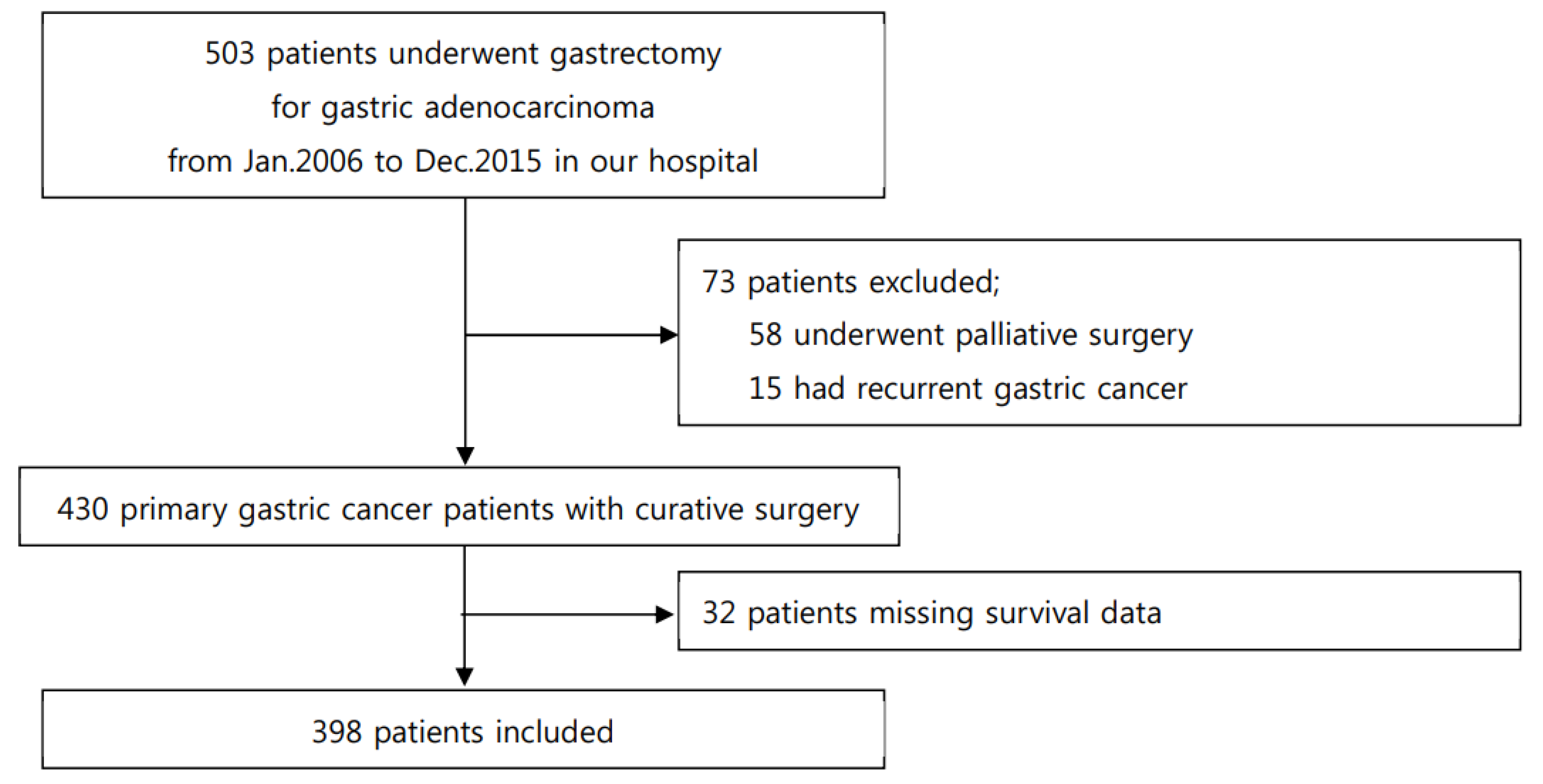
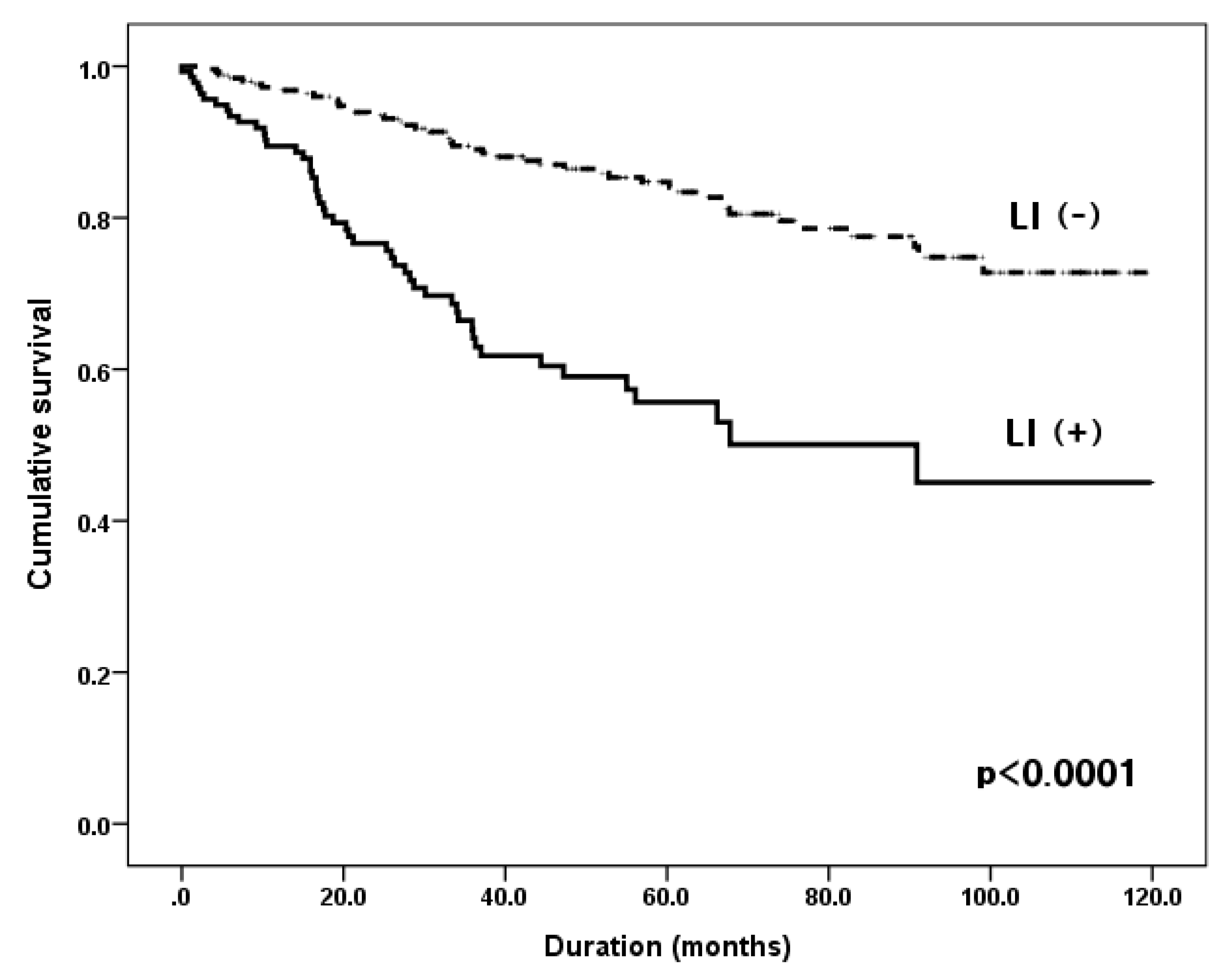
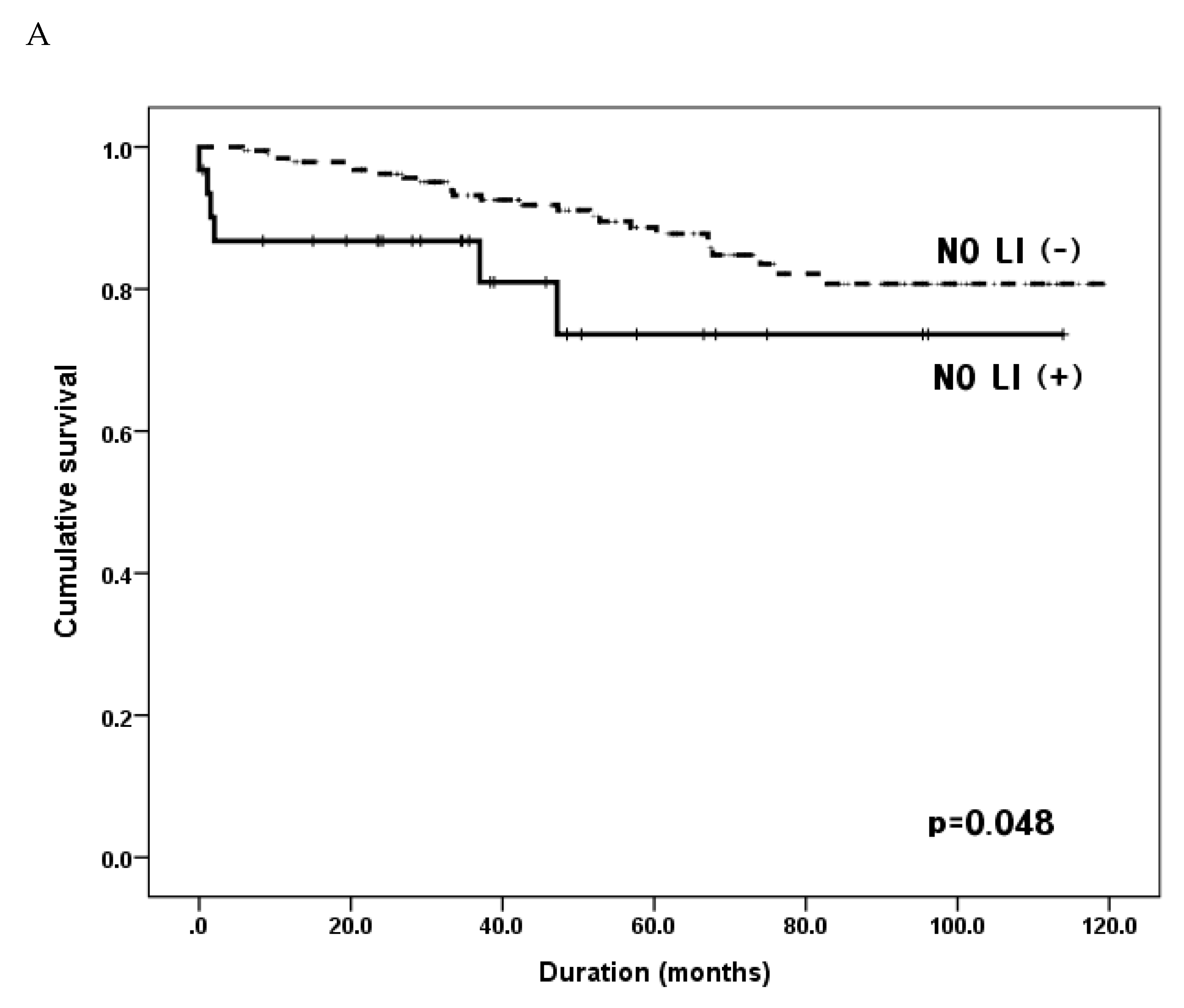
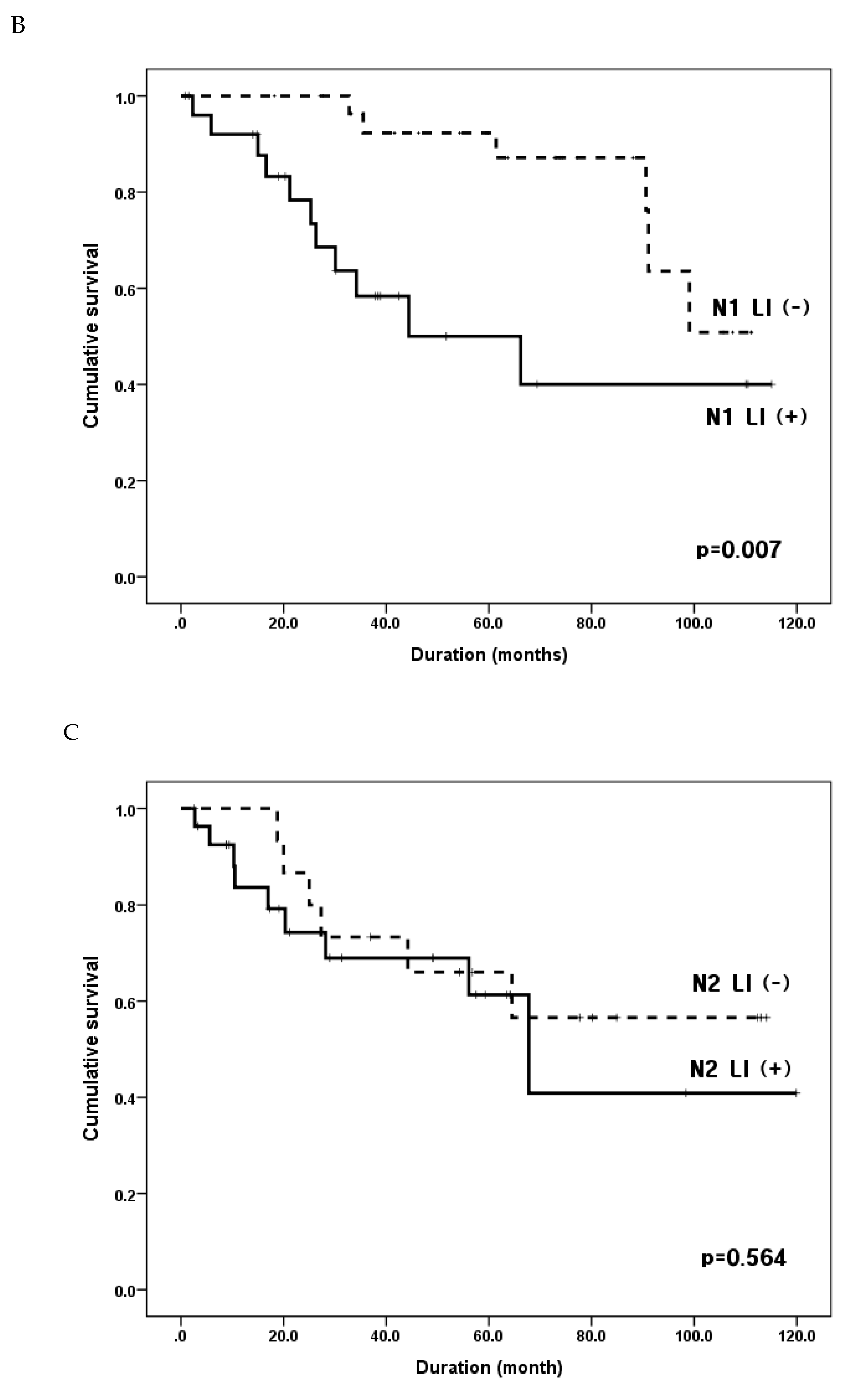
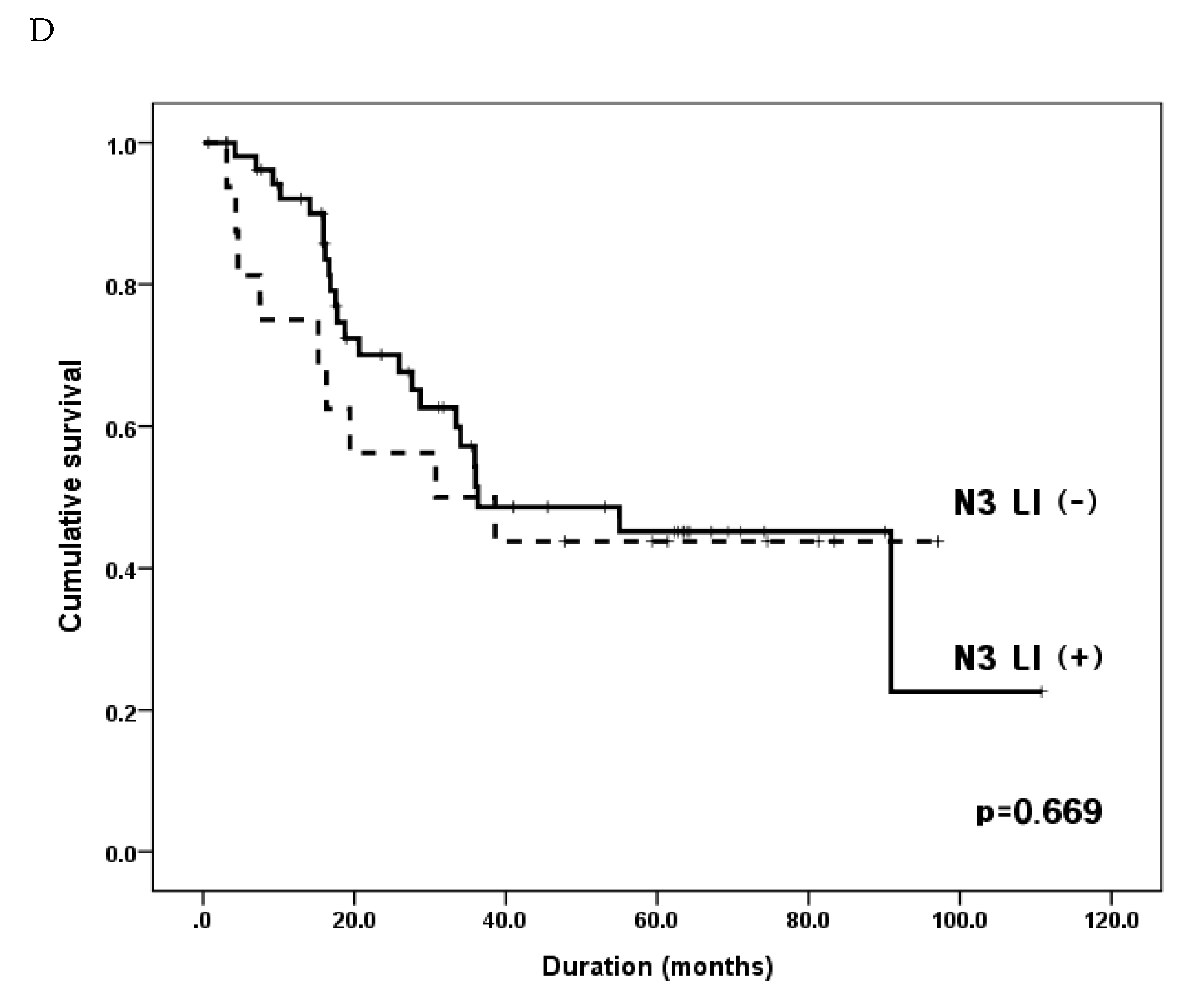
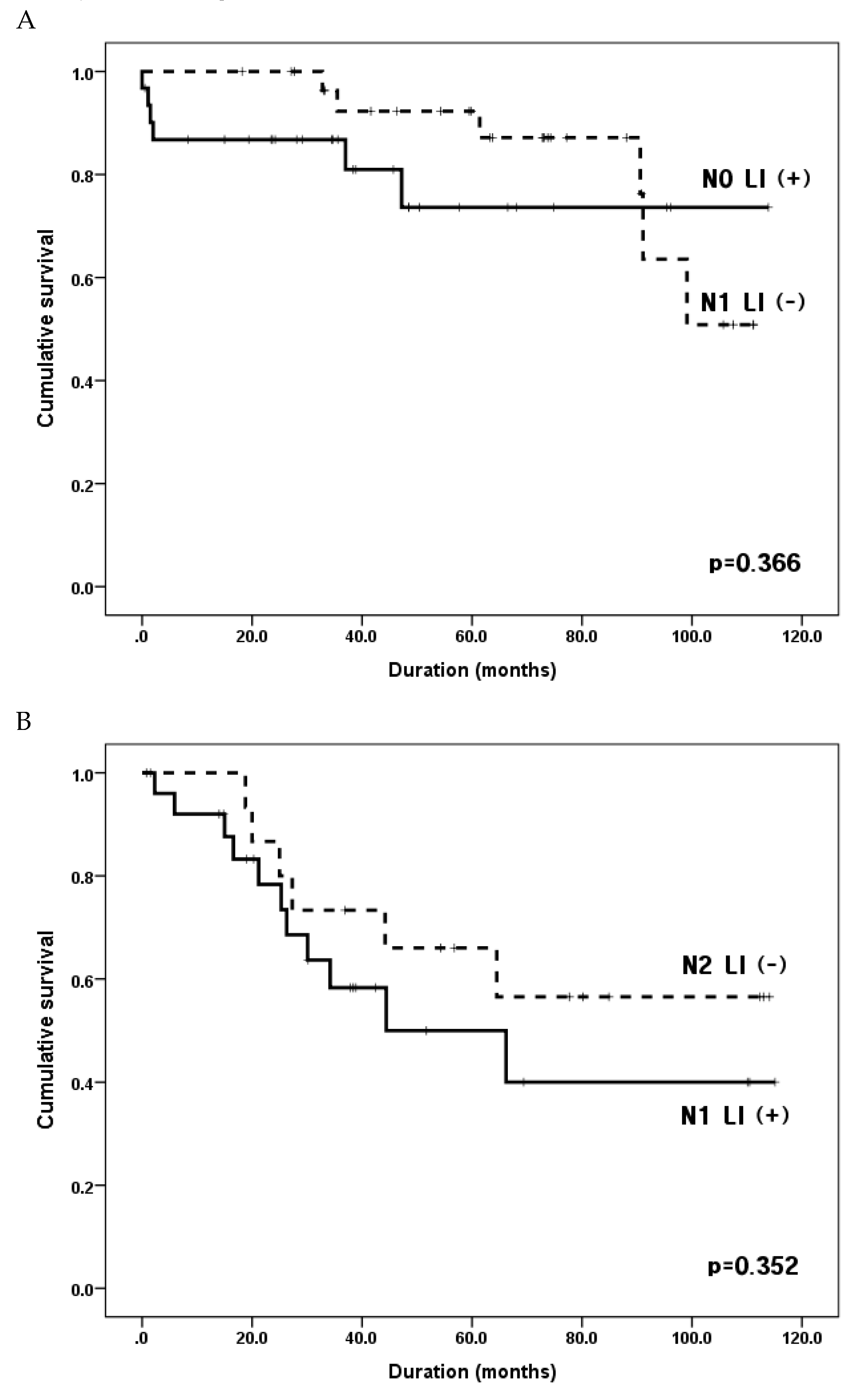
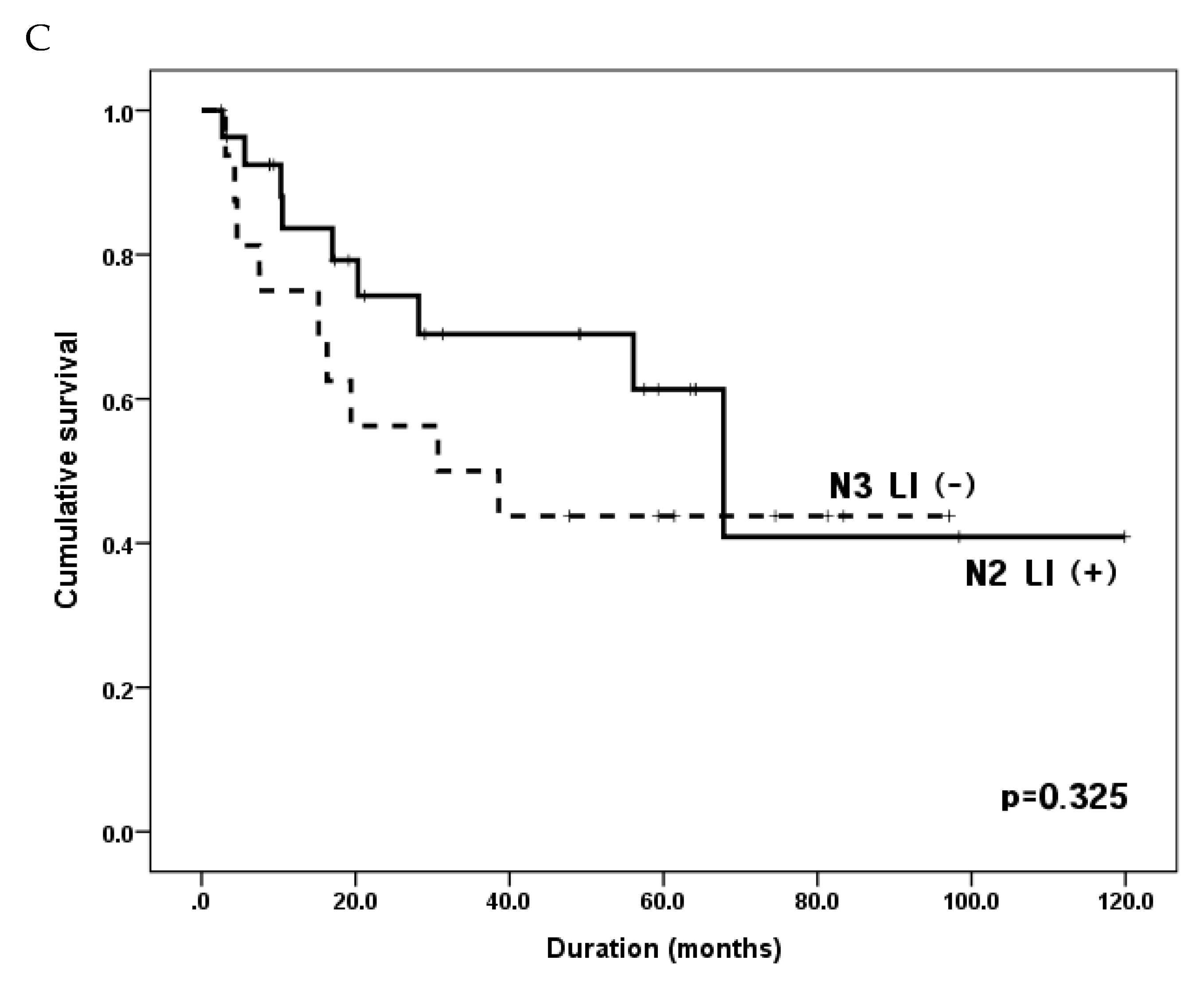
| Variables | No. of Patients (%) | Lymphatic Invasion (+) (n = 141) | Lymphatic Invasion (−) (n = 257) | p-Value |
|---|---|---|---|---|
| Age (years, mean ± SD) | 62.49 ± 11.33 | 59.31 ± 11.55 | 0.130 | |
| Gender | 0.073 | |||
| Male | 292 (73.4) | 111 (78.7) | 181 (70.4) | |
| Female | 106 (26.6) | 30 (21.3) | 76 (29.6) | |
| No. of cancer | 0.856 | |||
| Single | 371 (93.2) | 131 (92.9) | 240 (93.4) | |
| Multiple | 27 (6.8) | 10 (7.1) | 17 (6.6) | |
| Resection of stomach | 0.001 | |||
| Distal subtotal gastrectomy | 311 (78.5) | 98 (69.5) | 213 (82.9) | |
| Total gastrectomy | 85 (21.5) | 43 (30.5) | 42 (16.3) | |
| Other | 2 (0.8) | |||
| Tumor size (cm), (mean ± SD) | 5.59 ± 3.09 | 3.22 ± 2.31 | <0.0001 | |
| Histology | 0.697 | |||
| Differentiated | 231 (58.0) | 80 (56.7) | 151 (58.8) | |
| Undifferentiated | 167 (42.0) | 61 (43.3) | 106 (41.2) | |
| Tumor location | 0.332 | |||
| Upper 1/3 | 68 (17.1) | 29 (20.6) | 39 (15.2) | |
| Middle 1/3 | 77 (19.3) | 24 (17.0) | 53 (20.6) | |
| Lower 1/3 | 253 (63.6) | 88 (62.4) | 165 (64.2) | |
| Tumor depth | <0.0001 | |||
| Mucosa | 103 (25.9) | 0 (0.0) | 103 (40.1) | |
| Submucosa | 71 (17.8) | 13 (9.2) | 58 (22.5) | |
| Proper muscle | 50 (12.6) | 20 (14.2) | 30 (11.7) | |
| Subserosa | 102 (25.6) | 67 (47.5) | 35 (13.6) | |
| Serosa | 72 (18.1) | 41 (29.1) | 31 (12.1) | |
| N stage | <0.0001 | |||
| N0 | 227 (57.0) | 31 (22.0) | 196 (76.3) | |
| N1 | 57 (14.3) | 27 (19.1) | 30 (11.7) | |
| N2 | 43 (10.8) | 28 (19.9) | 15 (5.8) | |
| N3a | 47 (11.8) | 39 (27.7) | 8 (3.1) | |
| N3b | 24 (6.0) | 16 (11.3) | 8 (3.1) |
| Univariate Analysis | Multivariate Analysis | ||||||
|---|---|---|---|---|---|---|---|
| Variables | No. | 5YSR (%) | p-Value | OR | p-Value | 95% CI | |
| Lymphatic invasion | (−) | 226 | 89.2% | <0.0001 | 2.078 | 0.024 | 1.103–3.916 |
| (+) | 58 | 63.1% | |||||
| Age | ≤60 | 126 | 92.4% | 0.004 | 1.807 | 0.029 | 1.024–2.242 |
| >60 | 158 | 78.2% | |||||
| Gender | Male | 202 | 84.9% | 0.657 | |||
| Female | 82 | 83.8% | |||||
| No. of cancer | Single | 264 | 84.2% | 0.389 | |||
| Multiple | 20 | 89.5% | |||||
| Tumor size | <5 cm | 236 | 87.4% | 0.006 | 1.286 | 0.463 | 0.657–2.517 |
| >5 cm | 48 | 70.5% | |||||
| Histology | Differentiated | 171 | 83.4% | 0.580 | |||
| Undifferentiated | 113 | 86.3% | |||||
| Tumor location | Upper 1/3 | 43 | 84.5% | 0.411 | |||
| Middle 1/3 | 56 | 86.5% | |||||
| Lower 1/3 | 185 | 84.1% | |||||
| T stage | T1 | 172 | 89.3% | <0.001 | 1.430 | 0.013 | 1.078–1.897 |
| T2 | 42 | 88.7% | |||||
| T3 | 44 | 71.2% | |||||
| T4 | 26 | 70.7% | |||||
© 2020 by the authors. Licensee MDPI, Basel, Switzerland. This article is an open access article distributed under the terms and conditions of the Creative Commons Attribution (CC BY) license (http://creativecommons.org/licenses/by/4.0/).
Share and Cite
Choi, W.H.; Kim, M.J.; Park, J.H.; Kang, J.G.; Seo, S.I.; Kim, H.Y.; Shin, W.G. Lymphatic Invasion Might Be Considered as an Upstaging Factor in N0 and N1 Gastric Cancer. J. Clin. Med. 2020, 9, 1275. https://doi.org/10.3390/jcm9051275
Choi WH, Kim MJ, Park JH, Kang JG, Seo SI, Kim HY, Shin WG. Lymphatic Invasion Might Be Considered as an Upstaging Factor in N0 and N1 Gastric Cancer. Journal of Clinical Medicine. 2020; 9(5):1275. https://doi.org/10.3390/jcm9051275
Chicago/Turabian StyleChoi, Won Hyuk, Min Jeong Kim, Jun Ho Park, Jin Gu Kang, Seung In Seo, Hak Yang Kim, and Woon Geon Shin. 2020. "Lymphatic Invasion Might Be Considered as an Upstaging Factor in N0 and N1 Gastric Cancer" Journal of Clinical Medicine 9, no. 5: 1275. https://doi.org/10.3390/jcm9051275
APA StyleChoi, W. H., Kim, M. J., Park, J. H., Kang, J. G., Seo, S. I., Kim, H. Y., & Shin, W. G. (2020). Lymphatic Invasion Might Be Considered as an Upstaging Factor in N0 and N1 Gastric Cancer. Journal of Clinical Medicine, 9(5), 1275. https://doi.org/10.3390/jcm9051275





